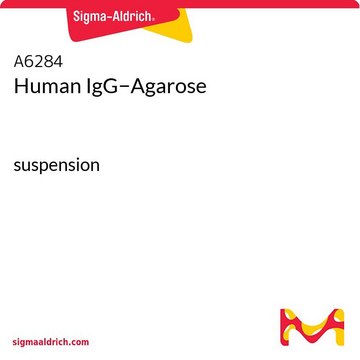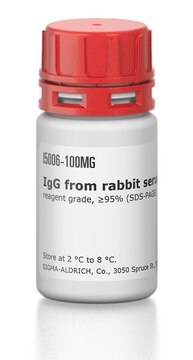A8914
Anti-Rabbit IgG (whole molecule)−Agarose antibody produced in goat
affinity isolated antibody, saline suspension
Sign Into View Organizational & Contract Pricing
All Photos(1)
About This Item
Recommended Products
biological source
goat
Quality Level
conjugate
agarose conjugate
antibody form
affinity isolated antibody
antibody product type
secondary antibodies
clone
polyclonal
form
saline suspension
extent of labeling
~1 mg per mL
technique(s)
immunoelectrophoresis: suitable
matrix
Cross-linked 4% beaded agarose
matrix activation
cyanogen bromide
matrix spacer
1 atom
capacity
≥0.25 mg/mL, resin binding capacity (rabbit IgG)
storage temp.
2-8°C
target post-translational modification
unmodified
Looking for similar products? Visit Product Comparison Guide
Related Categories
General description
IgG antibodies are found in all body fluids and are capable of fighting bacterial and viral infection. It is the only type of antibody capable of crossing the placenta and immunising the foetus. Anti-rabbit IgG (whole molecule)-agarose antibody can be used in immunoprecipitation. IgGs are added to nuclear extracts of breast cancer cell lines then immunoprecipitation carried out. Anti-rabbit IgG (whole molecule)-agarose antibody can react specifically to all rabbit immunoglobulin.
Immunogen
Purified rabbit IgG.
Application
Anti-rabbit IgG (whole molecule)-agarose antibody can be used in immunoprecipitation and immunoelectrophoresis.
Protein depletion from mouse intestinal cytosol samples was accomplished by incubating the samples with a specific primary and the pulling down with agarose-linked goat anti-rabbit IgG.
Physical form
Suspension in 0.5 M NaCl containing preservative.
Disclaimer
Unless otherwise stated in our catalog or other company documentation accompanying the product(s), our products are intended for research use only and are not to be used for any other purpose, which includes but is not limited to, unauthorized commercial uses, in vitro diagnostic uses, ex vivo or in vivo therapeutic uses or any type of consumption or application to humans or animals.
Not finding the right product?
Try our Product Selector Tool.
Storage Class Code
12 - Non Combustible Liquids
WGK
WGK 1
Flash Point(F)
Not applicable
Flash Point(C)
Not applicable
Choose from one of the most recent versions:
Already Own This Product?
Find documentation for the products that you have recently purchased in the Document Library.
The TACC proteins are coregulators of the Retinoid X Receptor b.
Ananthalaksmy K Vettaikkorumakankauv
Cancer Therapy, 6, 805-816 (2008)
Elissa L Sutcliffe et al.
Frontiers in immunology, 3, 260-260 (2012-09-13)
We recently provided the first description of a nuclear mechanism used by Protein Kinase C-theta (PKC-θ) to mediate T cell gene expression. In this mode, PKC-θ tethers to chromatin to form an active nuclear complex by interacting with proteins including
Shahzad Siddiqi et al.
Journal of lipid research, 51(5), 1093-1100 (2009-12-08)
The rate-limiting step in the transit of dietary fat across the intestinal absorptive cell is its exit from the endoplasmic reticulum (ER) in a specialized ER-to-Golgi transport vesicle, the prechylomicron transport vesicle (PCTV). PCTV bud off from the ER membranes
Brenda Lauffart et al.
The Biochemical journal, 363(Pt 1), 195-200 (2002-03-21)
Dysregulation of the human transforming acidic coiled-coil (TACC) proteins is thought to be important in the evolution of breast cancer and multiple myeloma. However, the exact role of these proteins in the oncogenic process is currently unknown. Using the full-length
Gang Li et al.
Nature cell biology, 13(5), 616-622 (2011-04-19)
The circadian clock controls many metabolic, developmental and physiological processes in a time-of-day-specific manner in both plants and animals. The photoreceptors involved in the perception of light and entrainment of the circadian clock have been well characterized in plants. However
Our team of scientists has experience in all areas of research including Life Science, Material Science, Chemical Synthesis, Chromatography, Analytical and many others.
Contact Technical Service






